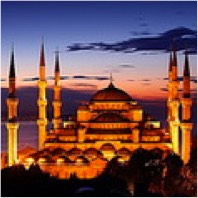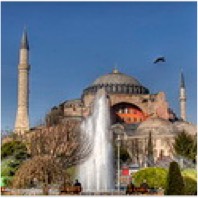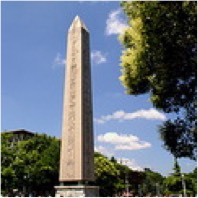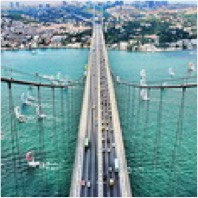Blue Mosque

Blue Mosque, also known as 'Sultan Ahmet Mosque' by local people, was built by Sultan Ahmet in 1609 and completed in 7 years, although foreigners have taken to calling it the Blue Mosque ' because of the beautiful blue Iznik tiles decorating the interior. The sultan choose his royal architect Sedefhar Mehmet Ağa , who was a senior assistant of the famous architect Sinan , to design the building.
Sultan Ahmet I wished to build an Islamic place of worship that would be even better than the Hagia Sophia, and the mosque named for him is the result. The two great architectural achievements now stand next to each other in Istanbul's main square, and it is up to visitors to decide which is more impressive.
It is not surprising that the design and organization of such great building was described in meticulous detail in eight volumes which now can be found in the library of Topkapı Palace . Among the other buildings of the complex , the mosque specially is without doubt one of the most wonderful monuments in the whole world . It is the only mosque that was originally built with six minarets and was included in the complex built by Sultan Ahmet I to compete with Hagia Sophia . It is also considered one of the last examples that exhibits classical Ottoman architecture.
One of the most notable features of the Blue Mosque is visible from far away, its six minarets. This is very unique, as most mosques have four, two, or just one minaret. According to one account, the Sultan directed his architect to make gold (altin) minarets, which was misunderstood as six (alti) minarets.
Whatever the origins of the unique feature, the six minarets caused quite a scandal, as the Haram Mosque in Mecca (the holiest in the world) also had six minarets. In the end, the sultan solved the problem by sending his architect to Mecca to add a seventh minaret.
The interior is lit with 260 windows, which were once filled with 17th-century stained glass. Sadly, this has been lost and replaced with inferior replicas. Not only was it built to serve as a mosque, but its huge surrounding complex also held a medrese (theological school), turbe (tomb), hospital, caravaserai, primary school, public kitchen and market, although the hospital and caravanserai were destroyed in the nineteenth century.
Blue mosque (its real name in Turkish; Sultan Ahmed Camii) is open to visit every day, just closed during prayer times (approximately a half hour during the each five daily prayers and it is closed for a longer time at midday on Friday, the Muslim holy day).
Visitors just can enter through the north gate and must remove their shoes at the entrance. Modest dress is required for both women and men; women should cover their heads. In mosques the areas of prayer for men and women are separate; while men pray at the front and centre, women sit at the back and the sides.
Sultan Ahmed Mosque is one of the best examples of classical Turkish architecture that you can visit.
Pope Benedict XVI visited Blue Mosque and he really liked it and before he left, he said “I am leaving half of my hearth in Istanbul”.







